中国是世界果品生产大国,自1993 年开始,水果栽培面积和产量均已超过印度、巴西和美国,位居世界第一[1-2]。发展水果产业是农民增收的主要途径,在农业生产中占据举足轻重的地位,同时果品又是重要的出口创汇农产品[3-5]。农药残留是影响食品(包括果品等食用农产品)质量安全的重要因素,其最大残留限量(maximum residue limit,MRL)标准是评价食品质量安全状况和实施质量安全监管的重要技术手段,也是各国政府和有关国际组织加强食品中农药残留风险管理的通行做法[6-7],在保障食品安全消费和发展国际贸易中发挥着重要的作用[8-9]。近年来,特别是“十三五”期间,农业农村部将加强农药残留国家标准体系建设作为重要任务,我国农药残留国家标准体系建设取得了积极进展,尤其是(GB 2763—2021)《食品安全国家标准食品中农药最大残留限量》的颁布,实现了我国农药残留国家标准体系建设的历史性跨越,果品中农药品种和残留限量标准数量也得到大幅度提升[7,10]。因此,对强制执行的现行有效国家标准GB 2763—2021中果品相关农药及限量标准进行系统比较分析,掌握我国果品中规定MRL的农药品种,弄清我国果品中农药MRL标准的现状,不仅为我国的食品中污染物限量标准制(修)订提供依据,同时对科学、合理地指导我国果品生产中农药的安全使用及提高果品质量安全水平有重要意义。
1 我国果品中农药残留限量标准发展历程
我国食品中农药MRL 标准最早可以追溯至我国制定的第一项食品中农药MRL 标准GBn 53—1977,该标准于1981 年被(GB 2763—1981)《粮食、蔬菜等食品中六六六、滴滴涕残留量标准》替代,此后不断加强修订和完善。2005年1月25日,我国颁布GB 2763—2005,同时废止和代替所有此前发布实施的农药MRL国家标准,自此(GB 2763)《食品安全国家标准食品中农药最大残留限量》成为我国统一规定食品中农药MRL的强制性国家标准(果品遵照执行)。由此认为,GB 2763 主要历次版本有GB 2763—1981[3]、GB 2763—2005[11]、GB 2763—2012[12]、GB 2763—2014[13]、GB 2763—2016[14][含补充版本(GB 2763.1—2018[15])《食品安全国家标准食品中百草枯等43 种农药最大残留限量》]、GB 2763—2019[16]、GB 2763—2021[17]。GB 2763—2021 由我国国家卫生健康委员会、农业农村部和国家市场监督管理总局联合发布,并于2021 年9 月3 日起正式实施,是我国目前唯一现行有效的食品中农药残留限量国家标准,规定了2,4-滴等564 种农药在376 种(类)食品中10 092 项残留限量标准,至此我国规定的食品中农药残留限量标准数量首次突破10 000项,全面覆盖了我国批准使用的农药品种和主要植物源性农产品,完成了国务院批准的《加快完善我国农药残留标准体系的工作方案》规定的目标任务,农药种类和限量标准数量达到国际食品法典委员会(Codex Alimentarius Commission,CAC)相关标准的近2 倍,标志着我国农药残留标准制定工作迈上了新台阶,将为我国规范科学合理用药、加强农产品质量安全监管、促进农产品国际贸易健康发展发挥重要作用[7,10]。与此同时,我国果品MRL 标准也由GB 2763—2005中的70种农药107项限量标准增加至GB 2763—2021 中的326 种农药2768 项限量。GB 2763 历次版本中规定的果品中农药种类及MRL标准数量分布见图1。

图1 GB2763 历次版本果品中农药及MRL 标准数量分布
Fig.1 Distribution of pesticide pesticides and MRL in previous versions of GB 2763
2 我国果品中农药残留限量标准现状
2.1 果品中规定MRL的禁限用农药
为了界定农药MRL 的应用范围,GB 2763—2021 将果品主要分为8 类,即柑橘类水果、仁果类水果、核果类水果、浆果和其他小型类水果、热带和亚热带类水果、瓜果类水果、干制水果和坚果。该标准对果品中2,4-滴等326 种农药规定有MRL 标准,豁免了低聚糖素等44 种低风险农药制定MRL标准,基本覆盖了我国批准使用的农药品种,缓解了“有农药登记、无限量标准”的历史遗留监管难题,有力地促进果品生产中农药科学规范使用,切实保障果品等食用农产品质量安全。在规定的326 种农药中(表1),允许使用的常规农药有2,4-滴和2,4-滴钠盐、阿维菌素和胺苯吡菌酮等277 种,占果品中规定MRL农药品种总数的85.0%;我国或全球范围的禁用农药有六六六、滴滴涕和毒杀芬等29种,占我国禁用农药的64.4%;限用农药有克百威、氧乐果和灭多威等20 种,占我国目前限用农药的71.4%。
表1 制定MRL 标准的禁限用农药
Table 1 Set maximum residue limitsof banned and restricted pesticides

注:表中字母A 表示氯丹、灭蚁灵、七氯、异狄氏剂等4 种农药属于全球范围内禁用农药,虽然不在我国禁用农药目录中,但仍一并列入禁用农药;字母B 表示甲拌磷以及甲基异柳磷、水胺硫磷、灭线磷等4 种农药已被列入我国禁用农药目录,将于2024 年9 月1 日起禁止使用;字母C 表示溴甲烷仅可用于“检疫熏蒸处理”。
Note:Letter A indicates that four pesticides such as chlordane,mirex,heptachlor,and endrin are banned pesticides in the world.Although they are not included in the list of banned pesticides in my country, they are still included in the list of banned pesticides; Letter B indicates that four pesticides such as phorate,isofenphos-methyl,isocarbophos and ethoprophos have been included in the list of banned pesticides in my country and will be banned from September 1,2024;Letter C indicates that methyl bromide can only be used for“quarantine fumigation”.
农药名称Pesticide name六六六,滴滴涕,毒杀芬,杀虫脒,艾氏剂,狄氏剂,甲胺磷,对硫磷,甲基对硫磷,久效磷,磷胺,苯线磷,地虫硫磷,甲基硫环磷,硫线磷,蝇毒磷,治螟磷,特丁硫磷,氯磺隆,胺苯磺隆,甲磺隆,三氯杀螨醇,硫丹,百草枯,杀扑磷,A氯丹,A灭蚁灵,A七氯,A异狄氏剂HCH, DDT, Camphechlor, Chlordimeform, Aldrin, Dieldrin, Methamidophos, Parathion, Parathion-methyl, Monocrotophos,Phosphamidon,Fenamiphos,Fonofos, Phosfolan-methyl,Cadusafos,Coumaphos,Sulfotep,Terbufos,Chlorsulfuron,Ethametsulfuron,Metsulfuron-methyl,Dicofol,Endosulfan,Paraquat,Methidathion,Chlordane,Mirex,Heptachlor,Endrin B甲拌磷,B甲基异柳磷,B水胺硫磷,B灭线磷,C溴甲烷,克百威,氧乐果,灭多威,涕灭威,内吸磷,硫环磷,氯唑磷,丁硫克百威,乙酰甲胺磷,乐果,毒死蜱,三唑磷,氰戊菊酯和S-氰戊菊酯,氟虫腈,氟苯虫酰胺Phorate, Isofenphos- methyl, Isocarbophos, Ethoprophos, Methylbromide, Carbofuran, Omethoate, Methomyl, Aldicarb,Demeton, Phosfolan, Isazofos, Carbosulfan, Acephate, Dimethoate, Chlorpyrifos, Triazophos, Fenvalerate and esfenvalerate,Fipronil,Flubendiamide农药种类Pesticide type禁用农药Banned pesticides限用农药Restricted pesticides
2.2 果品中农药MRL标准基本情况
在GB 2763—2021 对果品规定的326 种农药2768 项MRL 中,临时残留限量(temporary maximum residue limit,TMRL)650项,再残留限量(extraneous maximum residue limit,EMRL)55 项。按照果品类别来说(图2),柑橘类水果(217 种农药、534 项限量)及浆果和其他小型类水果(农药245 种、限量521 项)规定最多,其次为仁果类水果(246 种农药、432项限量)、热带和亚热带类水果(188种农药、377项限量)及核果类水果(农药193种、限量374项),而瓜果类水果、干制水果和坚果中规定的农药MRL标准相对较少。按照农药用途来说(表2),杀虫剂(122种农药、1117项限量)和杀菌剂(113种农药、1011项限量)最多,其次为除草剂(42种农药、259项限量)、杀螨剂(25种农药、246项限量),再次为植物生长调节剂(9种农药、47项限量)和杀虫/杀螨剂(5种农药、42项限量),另外杀线虫剂、熏蒸剂、杀虫/除草剂、杀螨/杀菌剂、杀软体动物剂和增效剂相对较少。按照农药使用规范来说(表3),常规农药277种制定残留限量2417项,占果品中限量标准总数量的87.3%;禁用农药29种制定的残留限量195项,占7.0%;限用农药20种制定的残留限量156项,占5.7%。
表2 MRL 标准在不同类别果品中分布
Table 2 The distribution of MRL in different categories of fruit products
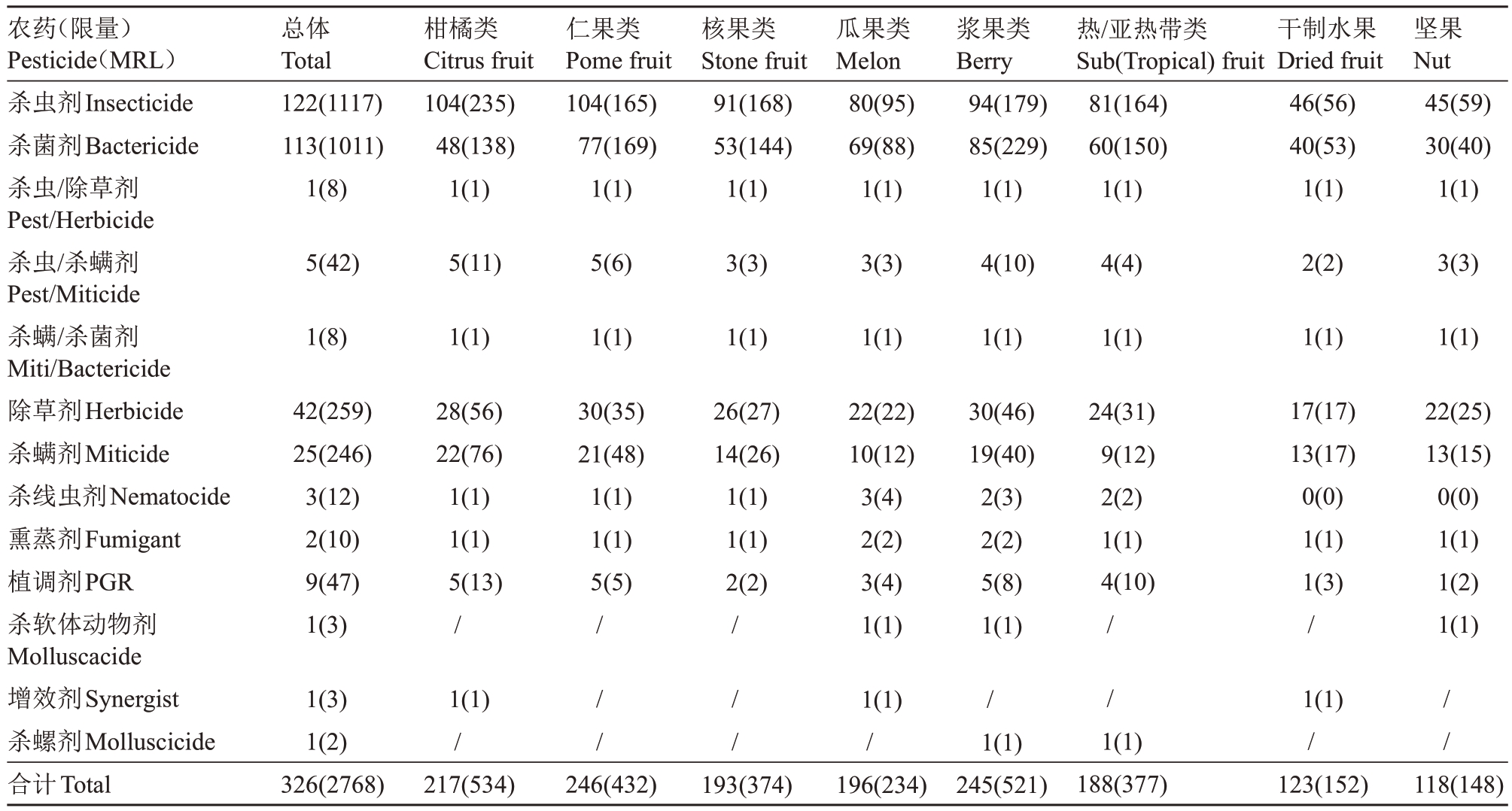
注:表中括号内数字为限量标准数量,括号外数字为农药种类数量。下同。
Note:Numbers inside()are the standard quantity of the limit andnumbers outside the()are the quantity of pesticide types.The same below.
农药(限量)Pesticide(MRL)杀虫剂Insecticide杀菌剂Bactericide杀虫/除草剂Pest/Herbicide杀虫/杀螨剂Pest/Miticide杀螨/杀菌剂Miti/Bactericide除草剂Herbicide杀螨剂Miticide杀线虫剂Nematocide熏蒸剂Fumigant植调剂PGR杀软体动物剂Molluscacide增效剂Synergist杀螺剂Molluscicide合计Total总体Total 122(1117)113(1011)1(8)柑橘类Citrus fruit 104(235)48(138)1(1)仁果类Pome fruit 104(165)77(169)1(1)核果类Stone fruit 91(168)53(144)1(1)瓜果类Melon 80(95)69(88)1(1)浆果类Berry 94(179)85(229)1(1)热/亚热带类Sub(Tropical)fruit 81(164)60(150)1(1)干制水果Dried fruit 46(56)40(53)1(1)坚果Nut 45(59)30(40)1(1)5(42)5(11)5(6)3(3)3(3)4(10)4(4)2(2)3(3)1(8)1(1)1(1)1(1)1(1)1(1)1(1)1(1)1(1)42(259)25(246)3(12)2(10)9(47)1(3)28(56)22(76)1(1)1(1)5(13)/30(35)21(48)1(1)1(1)5(5)26(27)14(26)1(1)1(1)2(2)22(22)10(12)3(4)2(2)3(4)1(1)30(46)19(40)2(3)2(2)5(8)1(1)24(31)9(12)2(2)1(1)4(10)17(17)13(17)0(0)1(1)1(3)/22(25)13(15)0(0)1(1)1(2)1(1)///////////118(148)1(3)1(2)326(2768)1(1)/217(534)246(432)193(374)1(1)/196(234)1(1)245(521)1(1)188(377)1(1)/123(152)
表3 果品中不同类型农药规定的MRL 标准数量分布
Table 3 Standard quantity distribution of MRL for different types of pesticides in fruits

限量类别MRL type常规农药CP禁用农药BUP限用农药RUP合计Total总体Total 277(2417)29(195)20(156)326(2768)柑橘类Citrus fruit 169(472)29(32)19(30)217(534)仁果类Pome fruit 197(376)29(30)20(26)246(432)核果类Stone fruit 145(323)29(29)19(22)193(374)瓜果类Melon 151(189)28(28)17(17)196(234)浆果类Berry 197(467)29(29)19(25)245(521)热/亚热带类Sub(Tropical)fruit 140(323)29(31)19(23)188(377)干制水果Dried fruit 110(138)6(6)7(8)123(152)坚果Nut 107(133)8(10)3(5)118(148)
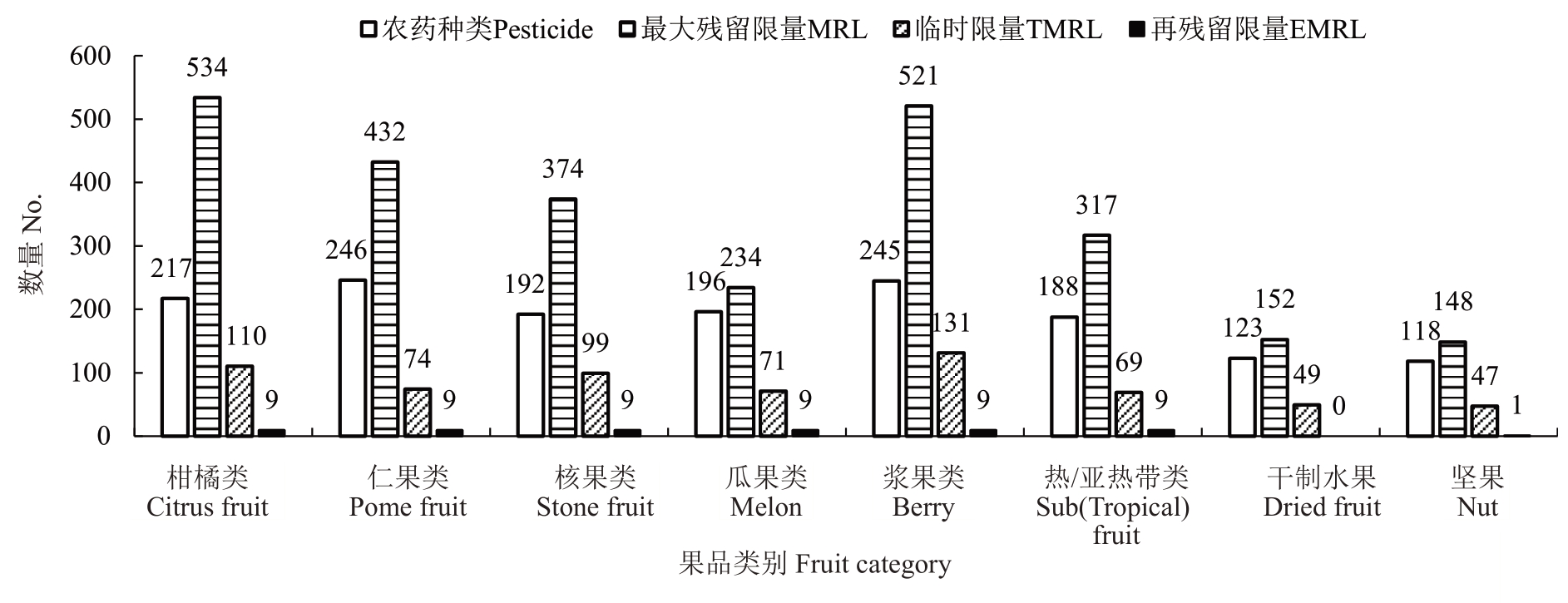
图2 果品中农药及MRL 标准数量分布
Fig.2 Distribution of pesticide pesticides and maximum residue limit standards
3 果品中农药残留限量标准GB 2763—2021主要变化
3.1 新增农药62种、新增限量标准722项
与GB 2763—2019 相比,GB 2763—2021 针对果品制定限量标准的农药增加了62 种(表4),主要包括巴毒磷、苯氧威等杀虫剂14种,胺苯吡菌酮、毒菌酚等杀菌剂13种,草枯醚、草芽畏等除草剂20种,格螨酯、环螨酯等杀螨剂7种,氟噻虫砜等杀线虫剂1种,氟节胺、烯效唑等植物生长调节剂2种,四聚乙醛等杀螺剂1 种,戊硝酚等杀虫/除草剂1 种,速灭磷、消螨酚等杀虫/杀螨剂2 种,乐杀螨等杀螨/杀菌剂1种,果品中相应限量标准增加了380项;另外,在针对果品制定有残留限量的已有农药基础上,水果限量新增359个;同时,由于枸杞(干)不再归为干制水果之列、个别单个果品限量标准统一按照果品大类别设定残留限量等,其限量标准数量相应减少。总体来说,GB 2763—2021 针对果品新增62 种农药、722项限量标准。
表4 新增62 种农药及相应限量标准
Table 4 Added 62 pesticides and corresponding MRL
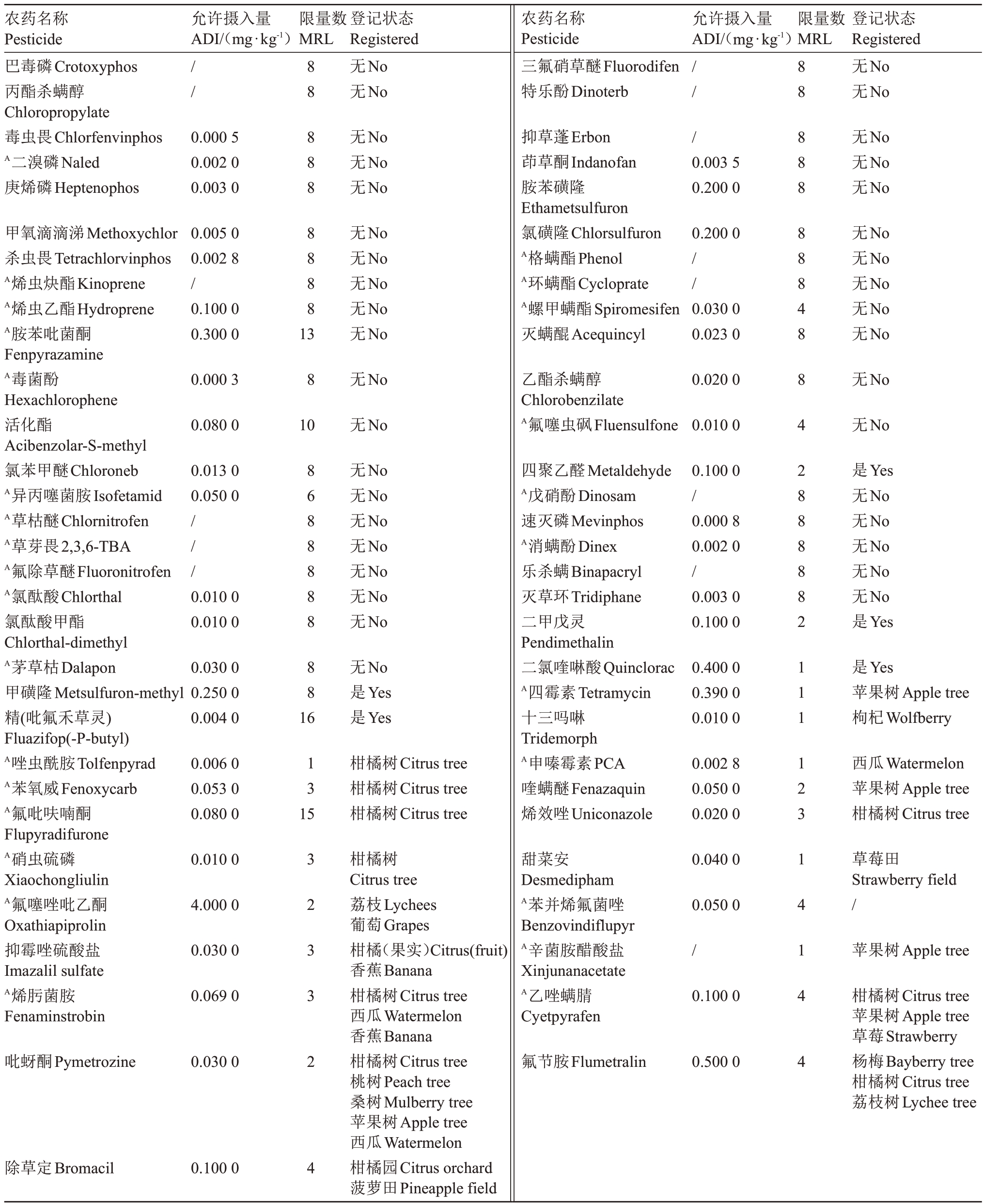
注:表中字母A 表示该农药没有推荐检测方法;字母T 表示该农药仅有临时ADI 值;“No”表示该农药在我国没有登记;“Yes”表示该农药虽然已在我国取得登记,但尚未在果树或水果中取得登记。
Note: Letter A indicates that there is no recommended detection method for this pesticide. Letter T indicates that the ADI value of the pesticide is temporary.“No”indicates that the pesticide has not been registered in China.“Yes”means that although the pesticide has been registered in China,it has not yet been registered in fruit trees or fruits.
农药名称Pesticide巴毒磷Crotoxyphos丙酯杀螨醇Chloropropylate毒虫畏Chlorfenvinphos A二溴磷Naled庚烯磷Heptenophos允许摄入量ADI/(mg·kg-1)限量数MRL允许摄入量ADI/(mg·kg-1)限量数MRL//登记状态Registered无No无No农药名称Pesticide三氟硝草醚Fluorodifen特乐酚Dinoterb登记状态Registered无No无No 0.000 5 0.002 0 0.003 0无No无No无No///0.003 5 0.200 0无No无No无No甲氧滴滴涕Methoxychlor杀虫畏Tetrachlorvinphos A烯虫炔酯Kinoprene A烯虫乙酯Hydroprene A胺苯吡菌酮Fenpyrazamine A毒菌酚Hexachlorophene活化酯Acibenzolar-S-methyl氯苯甲醚Chloroneb A异丙噻菌胺Isofetamid A草枯醚Chlornitrofen A草芽畏2,3,6-TBA A氟除草醚Fluoronitrofen A氯酞酸Chlorthal氯酞酸甲酯Chlorthal-dimethyl A茅草枯Dalapon甲磺隆Metsulfuron-methyl精(吡氟禾草灵)Fluazifop(-P-butyl)A唑虫酰胺Tolfenpyrad A苯氧威Fenoxycarb A氟吡呋喃酮Flupyradifurone A硝虫硫磷Xiaochongliulin A氟噻唑吡乙酮Oxathiapiprolin抑霉唑硫酸盐Imazalil sulfate A烯肟菌胺Fenaminstrobin 0.005 0 0.002 8/0.100 0 0.300 0 8 8 8 8 8 8 8 8 8 1无No无No无No无No无No抑草蓬Erbon茚草酮Indanofan胺苯磺隆Ethametsulfuron氯磺隆Chlorsulfuron A格螨酯Phenol A环螨酯Cycloprate A螺甲螨酯Spiromesifen灭螨醌Acequincyl 0.200 0//0.030 0 0.023 0无No无No无No无No无No 0.000 3无No 0.020 0无No 0.080 0 3 8 1无No乙酯杀螨醇Chlorobenzilate A氟噻虫砜Fluensulfone 0.010 0无No 0.013 0 0.050 0///0.010 0 0.010 0无No无No无No无No无No无No无No 0.100 0/0.000 8 0.002 0/0.003 0 0.100 0是Yes无No无No无No无No无No是Yes 0.030 0 0.250 0 0.004 0 0 8 6 8 8 8 8 8 8 8 1无No是Yes是Yes 0.400 0 0.390 0 0.010 0是Yes苹果树Apple tree枸杞Wolfberry 0.006 0 0.053 0 0.080 0 6 1 3 1柑橘树Citrus tree柑橘树Citrus tree柑橘树Citrus tree四聚乙醛Metaldehyde A戊硝酚Dinosam速灭磷Mevinphos A消螨酚Dinex乐杀螨Binapacryl灭草环Tridiphane二甲戊灵Pendimethalin二氯喹啉酸Quinclorac A四霉素Tetramycin十三吗啉Tridemorph A申嗪霉素PCA喹螨醚Fenazaquin烯效唑Uniconazole 0.002 8 0.050 0 0.020 0西瓜Watermelon苹果树Apple tree柑橘树Citrus tree 0.010 0 0.040 0 4.000 0 0.050 0草莓田Strawberry field/0.030 0/苹果树Apple tree 0.069 0甜菜安Desmedipham A苯并烯氟菌唑Benzovindiflupyr A辛菌胺醋酸盐Xinjunanacetate A乙唑螨腈Cyetpyrafen 0.100 0吡蚜酮Pymetrozine 0.030 0氟节胺Flumetralin 0.500 0 8 8 8 8 8 8 8 8 4 8 8 4 2 8 8 8 8 8 2 1 1 1 1 2 3 1 4 1 4 4柑橘树Citrus tree苹果树Apple tree草莓Strawberry杨梅Bayberry tree柑橘树Citrus tree荔枝树Lychee tree除草定Bromacil 0.100 0 5 3 2 3 3 2 4柑橘树Citrus tree荔枝Lychees葡萄Grapes柑橘(果实)Citrus(fruit)香蕉Banana柑橘树Citrus tree西瓜Watermelon香蕉Banana柑橘树Citrus tree桃树Peach tree桑树Mulberry tree苹果树Apple tree西瓜Watermelon柑橘园Citrus orchard菠萝田Pineapple field
新增的62 种农药中,苯氧威、二溴磷等27 种农药没有配套农药残留检测方法;巴毒磷、丙酯杀螨醇等14 种农药没有每日允许摄入量(acceptable daily intake,ADI)值,而庚烯磷、灭草环2种农药仅有临时ADI 值;巴毒磷、丙酯杀螨醇等37 种农药尚未在我国取得登记;苯并烯氟菌唑、吡氟禾草灵和精吡氟禾草灵、二甲戊灵、二氯喹啉酸、甲磺隆、四聚乙醛等7种农药虽然已在我国取得登记,但尚未在果树或水果中取得登记。新增的62 种农药中已在果树或水果中取得登记的农药所占比例不足30%。
3.2 修订9种农药残留物定义及4种农药ADI值
为保证膳食风险评估数据的科学性,参考FAO/WHO 农药残留专家联席会议(JMPR)评审结果,与GB 2763—2019 相比,GB 2763—2021 针对果品修订了吡氟禾草灵和精吡氟禾草灵、井冈霉素等9 种农药残留物监测定义(表5)[7,10];同时,还修订了喹禾灵和精喹禾灵、丁苯吗啉、氟苯脲等4种农药的ADI值(表6)。
表5 修订9 种农药残留物监测定义
Table 5 9 pesticides with revised monitoring residue definitions
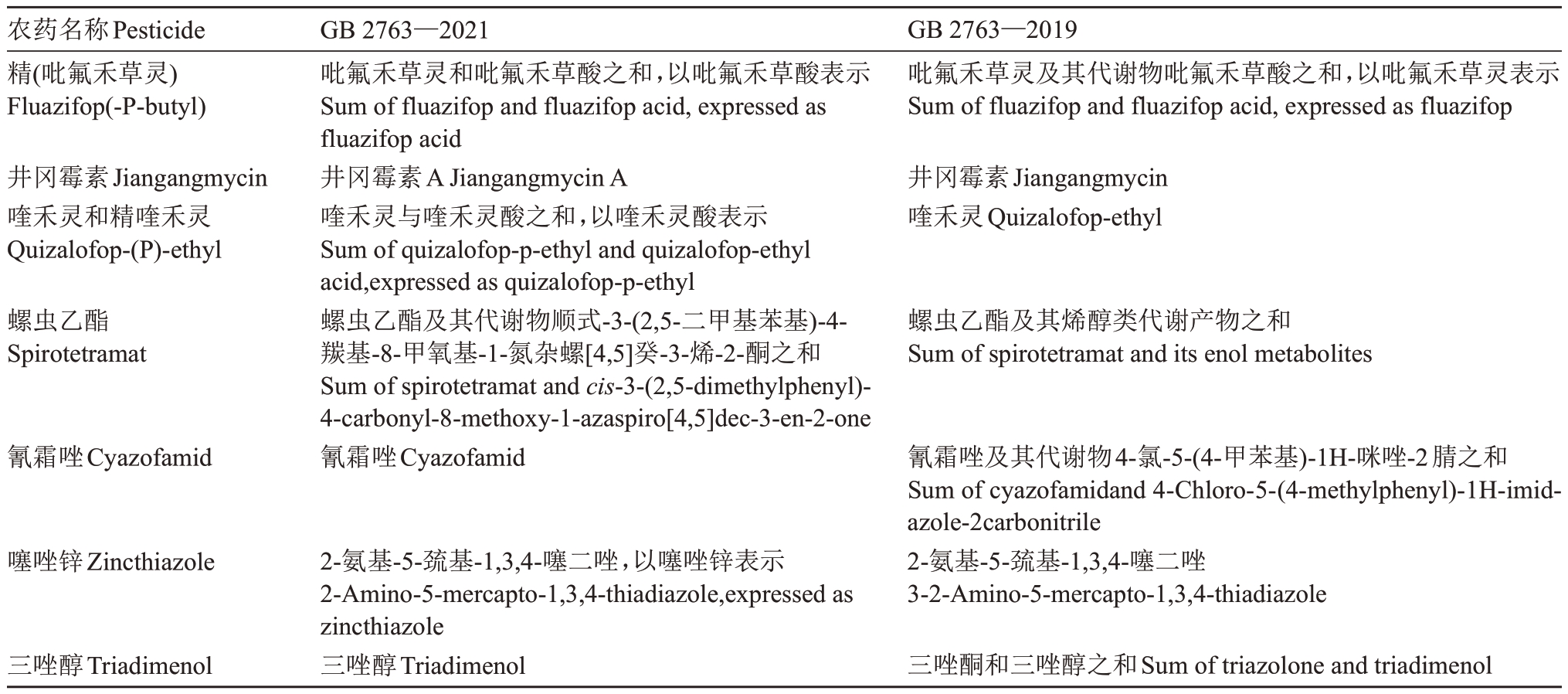
农药名称Pesticide精(吡氟禾草灵)Fluazifop(-P-butyl)GB 2763—2021吡氟禾草灵和吡氟禾草酸之和,以吡氟禾草酸表示Sum of fluazifop and fluazifop acid,expressed as fluazifop acid井冈霉素A Jiangangmycin A喹禾灵与喹禾灵酸之和,以喹禾灵酸表示Sum of quizalofop-p-ethyl and quizalofop-ethyl acid,expressed as quizalofop-p-ethyl螺虫乙酯及其代谢物顺式-3-(2,5-二甲基苯基)-4-羰基-8-甲氧基-1-氮杂螺[4,5]癸-3-烯-2-酮之和Sum of spirotetramat and cis-3-(2,5-dimethylphenyl)-4-carbonyl-8-methoxy-1-azaspiro[4,5]dec-3-en-2-one氰霜唑Cyazofamid GB 2763—2019吡氟禾草灵及其代谢物吡氟禾草酸之和,以吡氟禾草灵表示Sum of fluazifop and fluazifop acid,expressed as fluazifop井冈霉素Jiangangmycin喹禾灵和精喹禾灵Quizalofop-(P)-ethyl井冈霉素Jiangangmycin喹禾灵Quizalofop-ethyl螺虫乙酯Spirotetramat螺虫乙酯及其烯醇类代谢产物之和Sum of spirotetramat and its enol metabolites氰霜唑Cyazofamid噻唑锌Zincthiazole氰霜唑及其代谢物4-氯-5-(4-甲苯基)-1H-咪唑-2腈之和Sum of cyazofamidand 4-Chloro-5-(4-methylphenyl)-1H-imidazole-2carbonitrile 2-氨基-5-巯基-1,3,4-噻二唑3-2-Amino-5-mercapto-1,3,4-thiadiazole三唑醇Triadimenol 2-氨基-5-巯基-1,3,4-噻二唑,以噻唑锌表示2-Amino-5-mercapto-1,3,4-thiadiazole,expressed as zincthiazole三唑醇Triadimenol 三唑酮和三唑醇之和Sum of triazolone and triadimenol
表6 修订4 种农药每日允许摄入量
Table 6 4 pesticides with revised acceptabledailyintake(mg·kg-1)

农药名称Pesticide name喹禾灵和精喹禾灵Quizalofop-(P)-ethyl丁苯吗啉Fenpropimorph氟苯脲Teflubenzuron GB 2763—2019 0.003 0 0.010 0 0.000 9 GB 2763—2021 0.009 0.004 0.005
3.3 新增3种果品名称,修订3种果品名称
根据商品果品形态、主要用途及相关农药残留限量制定等情况,与GB 2763—2019 相比,GB 2763—2021 修订了规范性附录A(食品类别及测定部位),针对果品增加了香瓜茄、柑橘肉(干)和苹果干3种果品名称,修订了浆果和其他小型水果、热带和亚热带水果、杧果3种果品名称,同时将枸杞(干)的食品类别从干制水果调整为药用植物的花及果实类(表7)。
表7 新增或修订食品名称
Table 7 Added or amend food names

GB 2763—2021果品名称Fruit name香瓜茄Ginseng fruit柑橘肉(干)Dried citrus苹果干Dried apples杧果Mango枸杞(干)Wolfberry(dried)浆果和其他小型类水果Berries fruits热带和亚热带类水果Sub(tropical)fruits类别Type瓜果类水果Melons干制水果Dried fruit干制水果Dried fruit热带和亚热带类水果Sub(tropica)fruits药用植物中“花及果实类”“Flowers and Fruits”in medicinal plants浆果和其他小型类水果Berries fruits热带和亚热带类水果Sub(tropical)fruits GB 2763—2019果品名称Fruit name 类别Type//////杧果Mango枸杞(干)Wolfberry(dried)浆果和其他小型水果Berries fruits热带和亚热带水果Sub(tropical)fruits热带和亚热带水果Sub(tropical)fruits干制水果Dried fruit浆果和其他小型水果Berries fruits热带和亚热带水果Sub(tropical)fruits
3.4 修订部分农药MRL
与GB 2763—2019 相比,GB 2763—2021 针对果品规定的农药MRL,除了在限量标准数量上大幅新增之外,在限量类别、限量值及规定类别等方面也修订较多(表8)。
表8 修订的限量标准
Table 8 Revised maximum residue limits for pesticides
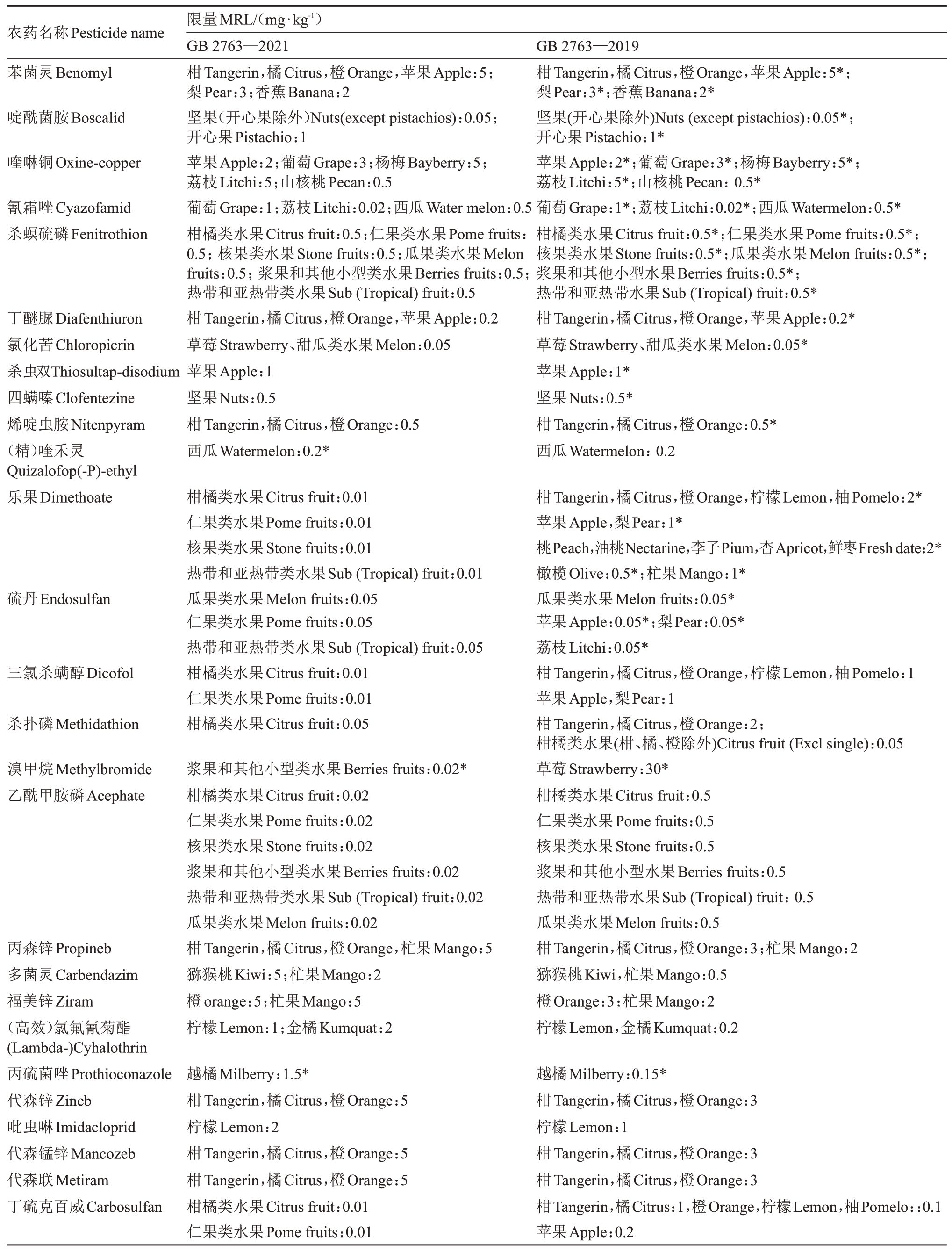
注:“*”表示该限量为临时限量。
Note:“*”indicates that the MRL is temporary.
农药名称Pesticide name苯菌灵Benomyl啶酰菌胺Boscalid喹啉铜Oxine-copper氰霜唑Cyazofamid杀螟硫磷Fenitrothion丁醚脲Diafenthiuron氯化苦Chloropicrin杀虫双Thiosultap-disodium四螨嗪Clofentezine烯啶虫胺Nitenpyram(精)喹禾灵Quizalofop(-P)-ethyl乐果Dimethoate限量MRL/(mg·kg-1)GB 2763—2021柑Tangerin,橘Citrus,橙Orange,苹果Apple:5;梨Pear:3;香蕉Banana:2坚果(开心果除外)Nuts(except pistachios):0.05;开心果Pistachio:1苹果Apple:2;葡萄Grape:3;杨梅Bayberry:5;荔枝Litchi:5;山核桃Pecan:0.5葡萄Grape:1;荔枝Litchi:0.02;西瓜Water melon:0.5柑橘类水果Citrus fruit:0.5;仁果类水果Pome fruits:0.5;核果类水果Stone fruits:0.5;瓜果类水果Melon fruits:0.5;浆果和其他小型类水果Berries fruits:0.5;热带和亚热带类水果Sub(Tropical)fruit:0.5柑Tangerin,橘Citrus,橙Orange,苹果Apple:0.2草莓Strawberry、甜瓜类水果Melon:0.05苹果Apple:1坚果Nuts:0.5柑Tangerin,橘Citrus,橙Orange:0.5西瓜Watermelon:0.2*GB 2763—2019柑Tangerin,橘Citrus,橙Orange,苹果Apple:5*;梨Pear:3*;香蕉Banana:2*坚果(开心果除外)Nuts(except pistachios):0.05*;开心果Pistachio:1*苹果Apple:2*;葡萄Grape:3*;杨梅Bayberry:5*;荔枝Litchi:5*;山核桃Pecan:0.5*葡萄Grape:1*;荔枝Litchi:0.02*;西瓜Watermelon:0.5*柑橘类水果Citrus fruit:0.5*;仁果类水果Pome fruits:0.5*;核果类水果Stone fruits:0.5*;瓜果类水果Melon fruits:0.5*;浆果和其他小型水果Berries fruits:0.5*;热带和亚热带水果Sub(Tropical)fruit:0.5*柑Tangerin,橘Citrus,橙Orange,苹果Apple:0.2*草莓Strawberry、甜瓜类水果Melon:0.05*苹果Apple:1*坚果Nuts:0.5*柑Tangerin,橘Citrus,橙Orange:0.5*西瓜Watermelon:0.2硫丹Endosulfan三氯杀螨醇Dicofol杀扑磷Methidathion柑橘类水果Citrus fruit:0.01仁果类水果Pome fruits:0.01核果类水果Stone fruits:0.01热带和亚热带类水果Sub(Tropical)fruit:0.01瓜果类水果Melon fruits:0.05仁果类水果Pome fruits:0.05热带和亚热带类水果Sub(Tropical)fruit:0.05柑橘类水果Citrus fruit:0.01仁果类水果Pome fruits:0.01柑橘类水果Citrus fruit:0.05溴甲烷Methylbromide乙酰甲胺磷Acephate丙森锌Propineb多菌灵Carbendazim福美锌Ziram(高效)氯氟氰菊酯(Lambda-)Cyhalothrin丙硫菌唑Prothioconazole代森锌Zineb吡虫啉Imidacloprid代森锰锌Mancozeb代森联Metiram丁硫克百威Carbosulfan浆果和其他小型类水果Berries fruits:0.02*柑橘类水果Citrus fruit:0.02仁果类水果Pome fruits:0.02核果类水果Stone fruits:0.02浆果和其他小型类水果Berries fruits:0.02热带和亚热带类水果Sub(Tropical)fruit:0.02瓜果类水果Melon fruits:0.02柑Tangerin,橘Citrus,橙Orange,杧果Mango:5猕猴桃Kiwi:5;杧果Mango:2橙orange:5;杧果Mango:5柠檬Lemon:1;金橘Kumquat:2柑Tangerin,橘Citrus,橙Orange,柠檬Lemon,柚Pomelo:2*苹果Apple,梨Pear:1*桃Peach,油桃Nectarine,李子Pium,杏Apricot,鲜枣Fresh date:2*橄榄Olive:0.5*;杧果Mango:1*瓜果类水果Melon fruits:0.05*苹果Apple:0.05*;梨Pear:0.05*荔枝Litchi:0.05*柑Tangerin,橘Citrus,橙Orange,柠檬Lemon,柚Pomelo:1苹果Apple,梨Pear:1柑Tangerin,橘Citrus,橙Orange:2;柑橘类水果(柑、橘、橙除外)Citrus fruit(Excl single):0.05草莓Strawberry:30*柑橘类水果Citrus fruit:0.5仁果类水果Pome fruits:0.5核果类水果Stone fruits:0.5浆果和其他小型水果Berries fruits:0.5热带和亚热带水果Sub(Tropical)fruit:0.5瓜果类水果Melon fruits:0.5柑Tangerin,橘Citrus,橙Orange:3;杧果Mango:2猕猴桃Kiwi,杧果Mango:0.5橙Orange:3;杧果Mango:2柠檬Lemon,金橘Kumquat:0.2越橘Milberry:0.15*柑Tangerin,橘Citrus,橙Orange:3柠檬Lemon:1柑Tangerin,橘Citrus,橙Orange:3柑Tangerin,橘Citrus,橙Orange:3柑Tangerin,橘Citrus:1,橙Orange,柠檬Lemon,柚Pomelo::0.1苹果Apple:0.2越橘Milberry:1.5*柑Tangerin,橘Citrus,橙Orange:5柠檬Lemon:2柑Tangerin,橘Citrus,橙Orange:5柑Tangerin,橘Citrus,橙Orange:5柑橘类水果Citrus fruit:0.01仁果类水果Pome fruits:0.01
(1)限量类别的改变。由于配套农药残留检测方法的推荐增补,将果品中苯菌灵、丁醚脲和啶酰菌胺等13 种农药的51 项限量由临时限量修改为正式限量。例如苯菌灵在柑、橘、橙和苹果中的限量5 mg·kg-1、在梨中限量3 mg·kg-1和在香蕉中限量2 mg·kg-1,以及丁醚脲在柑、橘、橙和苹果中的限量0.2 mg·kg-1等,均由原来的临时限量修订为正式限量。同时由于缺乏配套检测方法,喹禾灵和精喹禾灵在西瓜中的限量0.2 mg·kg-1由正式限量修改为临时限量。
(2)限量值的改变。由于禁用管理政策的实施、新的农药登记残留实验数据的获得以及残留定义的规范统一等,并基于膳食风险评估结果,对乐果、三氯杀螨醇等16 种农药在柑、橘和橙等果品中的54 项限量标准值进行了修订[7,10]。例如丙硫菌唑在越橘中的限量由原来的0.15 mg·kg-1修订为1.5 mg·kg-1,丙森锌在柑、橘、橙中的3 mg·kg-1以及杧果中的2 mg·kg-1修订为5 mg·kg-1。
(3)部分禁限用农药按照定量限水平设置限量,并将单个果品限量修订为组限量。此次修订涉及的三氯杀螨醇、杀扑磷、硫丹和溴甲烷等禁用农药以及乐果、乙酰甲胺磷等限用农药均按照检测方法的定量限水平设置限量,并将单个果品限量修订为组限量。同时需要指出的是,本次修订的限量,有要求更严格的,也有要求变宽的,在实际应用时应特别关注。例如三氯杀螨醇在柑、橘、橙、柠檬和柚中的限量1 mg·kg-1修订为柑橘类水果0.01 mg·kg-1,在苹果、梨中的限量1 mg·kg-1 修订为仁果类水果0.01 mg·kg-1,降幅100 倍;溴甲烷在草莓中的限量由30 mg·kg-1修订为0.02 mg·kg-1,降幅1500倍。另外,丙森锌在柑、橘和橙中的限量3 mg·kg-1、在杧果中的限量2 mg·kg-1修订为5 mg·kg-1;代森锌在柑、橘和橙中的限量由3 mg·kg-1修订为5 mg·kg-1等,均有不同程度的变宽。
3.5 调整部分配套农药残留检测方法
与GB 2763—2019 相比,GB 2763—2021 调整的检测方法标准中(表9),增加4 项即GB 23200.116、GB 23200.117、SN/T4066 和SN/T 4591,修订1项SN/T 0654,删除1项GB/T 5009.110。配套农药残留检测方法标准的调整,有效解决了部分农药残留标准“有限量、无方法”的问题[7,10]。
表9 调整的检测方法标准
Table 9 Adjustment method standard for adjustment

方法标准Standard GB 23200.116农药残留Pesticide residue乙酰甲胺磷,乐果,杀扑磷,巴毒磷,丙溴磷,毒菌酚,毒死蜱,甲拌磷,甲基异柳磷,乐果,三唑磷,速灭磷,亚胺硫磷Acephate,Dimethoate,Methidathion,Crotoxyphos,Profenofos,Hexachlorophene,Chlorpyrifos,Phorate,Isofenphos-methyl,Dimethoate,Triazophos,Mevinphos,Mhosmet喹啉铜Oxine-copper灭螨醌Acequincyl氟苯脲,氟啶胺,特乐酚Teflubenzuron,Fluazinam,Dinoterb克菌丹Captan氯氰菊酯,氰戊菊酯,溴氰菊酯Cypermethrin,Fenvalerate,Deltamethrin备注Note新增New GB 23200.117 SN/T 4066 SN/T 4591 SN/T 0654 GB/T 5009.110新增New新增New新增New修订Revise(SN 0654)删除Delete
4 我国果品中农药MRL标准特征
与GB 2763—2019 相比,GB 2763—2021 的颁布,极大程度上改善了以往果品中规定残留限量标准的农药种类少[1]、个别农药残留物监测定义和ADI值不够科学[7]、限量标准数量不足且与国际接轨不够紧密等现状[9],更有利果品生产中农药的安全使用和监管,更能促进果品质量安全水平的提高,标志着我国农药残留标准制(修)订迈上了新台阶。总体来说,我国果品中农药MRL标准有如下特征。
4.1 涵盖农药品种和限量标准数量大幅增加
农药品种增加62种,增幅23.5%,现有的326种农药加上豁免制定MRL 的44 种低风险农药,基本涵盖了我国批准在果品生产中允许使用的绝大多数农药;农药残留限量标准数量增加722 项,增幅35.3%,现有的2768 项限量标准占食品总限量数的27.4%。基本解决了相关部门对农产品安全监管时部分登记农药、部分果品“无标可依”的难题。
4.2 限量值的设置体现了“四个最严”的要求
针对社会关注度高的果品,设定了29种禁用农药195项限量标准、20种限用农药156项限量标准,并将部分禁限用农药按照检测方法的定量限水平设置限量值,同时将部分农药单个果品限量修订为组限量,很大程度上扩大了果品质量安全监管的范围,实现了对相应禁限用范围果品种类的全覆盖,强化了违规使用禁限用农药的监管。
4.3 标准制定更加科学严谨并与国际接轨
GB 2763—2021 是基于我国农药登记残留试验、市场监测、居民膳食消费和农药毒理学等数据制定的,遵照CAC 通行做法开展风险评估,广泛征求专家、社会公众、相关部门和机构等利益相关方意见,并接受世界贸易组织成员的评议。采用的风险评估原则、方法和数据等要求与CAC和发达国家接轨。将苯菌灵、丁醚脲和啶酰菌胺等13种农药的51项限量由临时限量修改为正式限量,将喹禾灵和精喹禾灵在西瓜中的限量由正式限量修改为临时限量,修订乐果、三氯杀螨醇和杀扑磷等16 种农药在柑、橘和橙等果品中的54项限量值。
4.4 农药残留物监测定义和ADI值更科学
与果品有关的农药中,修订吡氟禾草灵和精吡氟禾草灵、井冈霉素等9 种农药残留物定义及喹禾灵和精喹禾灵、丁苯吗啉等4种农药ADI值,使得这些农药膳食风险评估数据更可靠,在一定程度上保证了膳食风险评估数据的科学性。
4.5 配套检测方法进一步完善
与果品有关的配套农药残留检测方法标准中,增加4项即GB 23200.116、GB 23200.117、SN/T 4066和SN/T 4591,修订1 项SN/T 06542,删除1 项GB/T 5009.1102。GB 2763—2021规定的农药残留检测方法具有法定性,配套检测方法标准的调整与完善,有效解决了部分农药残留标准“有限量、无方法”的问题。
[1]庞荣丽,王瑞萍,郭琳琳,乔成奎,罗静,田发军,王彩霞,李君,谢汉忠.我国果品中农药残留限量标准现状分析[J].果树学报,2020,37(8):1236-1246.PANG Rongli,WANG Ruiping,GUO Linlin,QIAO Chengkui,LUO Jing,TIAN Fajun,WANG Caixia,LI Jun,XIE Hanzhong.Evaluation of the current standard for pesticide residue limits in fruitsinChina[J].JournalofFruitScience,2020,37(8):1236-1246.
[2]杨洲,郭晓伶,汪刘一,吴良军,陈林斌.果园电动修剪机具与技术研究进展[J].果树学报,2015,32(4):712-719.YANG Zhou,GUO Xiaoling,WANG Liuyi,WU Liangjun,CHEN Linbin. Review on electric pruning equipments and technology in orchard[J]. Journal of Fruit Science,2015,32(4):712-719.
[3]聂继云,匡立学,沈友明.我国果品农药最大残留限量标准沿革与现状[J].中国果树,2019(3):107-109.NIE Jiyun,KUANG Lixue,SHEN Youming. Evolution and status of maximum pesticide residue limits standards for fruit in China[J].China Fruits,2019(3):107-109.
[4]庞荣丽,吴斯洋,郭琳琳,李君,谢汉忠.我国西瓜甜瓜质量安全标准现状及存在问题和建议[J].中国瓜菜,2019,32(6):1-8.PANG Rongli,WU Siyang,GUO Linlin,LI Jun,XIE Hanzhong. Status,problems and suggestions of quality and safety standards in watermelon and melon in China[J]. China Cucurbits and Vegetables,2019,32(6):1-8.
[5]张思远,方琪,焦必宁.果品中有机磷农药联合毒性研究进展[J].果树学报,2017,34(1):94-105.ZHANG Siyuan,FANG Qi,JIAO Bining. Research progress of combined toxicity induced by organophosphorus pesticides in fruits[J].Journal of Fruit Science,2017,34(1):94-105.
[6]毋永龙,聂继云,李志霞,李静,李海飞,徐国锋,闫震,匡立学.我国和CAC 新鲜水果农药残留限量标准比对研究[J].农产品质量与安全,2015(2):31-34.WU Yonglong,NIE Jiyun,LI Zhixia,LI Jing,LI Haifei,XU Guofeng,YAN Zhen,KUANG Lixue. Comparison of pesticide residue limit standards between China and CAC[J]. Quality and Safety of Agro-Products,2015(2):31-34.
[7]李富根,朴秀英,廖先骏,朱光艳,秦冬梅,穆兰,罗媛媛.农药残留国家标准体系建设现状与展望[J].现代农药,2021,20(6):1-5.LI Fugen,PIAO Xiuying,LIAO Xianjun,ZHU Guangyan,QIN Dongmei,MU Lan,LUO Yuanyuan. Present situation and prospect of system construction of pesticide residue national standard[J].Modern Agrochemicals,2021,20(6):1-5.
[8]庞荣丽,成昕,谢汉忠,王瑞萍,郭琳琳,方金豹.我国水果质量安全标准现状分析[J].果树学报,2016,33(5):612-623.PANG Rongli,CHENG Xi,XIE Hanzhong,WANG Ruiping,GUO Linlin,FANG Jinbao. Current status of fruit quality safety standardsinChina[J].JournalofFruitScience,2016,33(5):612-623.
[9]梁道崴,张耀海,王成秋,焦必宁.国内外柑橘中农药最大残留限量标准的比较分析[J].食品与发酵工业,2022,48(3):273-283.LIANG Daowei,ZHANG Yaohai,WANG Chengqiu,JIAO Bining. Comparative analysis of national and international standards of maximum residue limits for pesticides in Citrus[J].Food and Fermentation Industries,2022,48(3):273-283.
[10]中华人民共和国农业农村部.我国农药残留限量标准突破1万项全面覆盖我国批准使用的农药品种和主要植物源性农产品[EB/OL]. (2021-01-01)[2022-06-20].http://www.moa.gov.cn/xw/zwdt/202104/t20210401_6365132.htm.Ministry of Agriculture and Rural Affairs of the people’s Republic of China.The standard of pesticide residue limit exceeded 10,000 items to comprehensively cover the pesticide varieties and main plant-derived agricultural products approved for use in China. [EB/OL]. (2021-01-01)[2022-06-20].http://www.moa.gov.cn/xw/zwdt/202104/t20210401_6365132.htm.
[11]中华人民共和国农业部,中国国家标准化管理委员会.食品中农药最大残留限量:GB 2763—2005[S].北京:中国农业出版社,2005.Ministry of Agriculture of the people’s Republic of China,China National Standardization Committee. Maximum residue limits for pesticides in food:GB 2763—2005[S].Beijing:Standards Press of China,2005.
[12]中华人民共和国国家卫生部,中华人民共和国农业部.食品安全国家标准食品中农药最大残留限量:GB 2763—2012[S].北京:中国标准出版社,2012.Ministry of Health of the People′s Republic of China,Ministry of Agriculture of the People’s Republic of China. National food safety standard-maximum residue limits for pesticides in food:GB 2763—2012[S].Beijing:Standards Press of China,2012.
[13]中华人民共和国国家卫生和计划生育委员会,中华人民共和国农业部.食品安全国家标准食品中农药最大残留限量:GB 2763—2014[S].北京:中国标准出版社,2014.National Health and Family Planning Commission of the People′s Republic of China,Ministry of Agriculture of the People’s Republic of China.National food safety standard-maximum residue limits for pesticides in food:GB 2763—2014[S]. Beijing:Standards Press of China,2014.
[14]中华人民共和国国家卫生和计划生育委员会,中华人民共和国农业部,国家食品药品监督管理总局.食品安全国家标准食品中农药最大残留限量:GB 2763—2016[S].北京:中国标准出版社,2016.National Health and Family Planning Commission ,Ministry of Agriculture,State Food and Drug Administrationof the People’s Republic of China. National food safety standard--Maximum residue limits for pesticides in food:GB 2763—2016[S]. Beijing:Standards Press of China,2016.
[15]中华人民共和国国家卫生健康委员会,中华人民共和国农业农村部,国家市场监督管理总局.食品安全国家标准食品中百草枯等43 种农药最大残留限量:GB 2763.1—2018[S]. 北京:中国标准出版社,2018.National Health Commission of the People’s Republic of China,Ministry of Agriculture and Rural Affairs of the People’s Republic of China,State Administration of Market Supervision. National food safety standard-maximum residue limits for pesticides in food:GB 2763.1—2018[S]. Beijing:Standards Press of China,2018.
[16]中华人民共和国国家卫生健康委员会,中华人民共和国农业农村部,国家市场监督管理总局.食品安全国家标准食品中农药最大残留限量:GB 2763—2019[S].北京:中国农业出版社,2019.National Health Commission of the People’s Republic of China,Ministry of Agriculture and Rural Affairs of the People’s Republic of China,State Administration of Market Supervision. National food safety standard-maximum residue limits for pesticides in food:GB 2763—2019[S]. Beijing:Standards Press of China,2019.
[17]中华人民共和国国家卫生健康委员会,中华人民共和国农业农村部,国家市场监督管理总局.食品安全国家标准食品中农药最大残留限量:GB 2763—2021[S].北京:中国农业出版社,2021.National Health Commission of the People’s Republic of China,Ministry of Agriculture and Rural Affairs of the People’s Republic of China,State Administration of Market Supervision. National food safety standard-maximum residue limits for pesticides in food:GB 2763—2021[S]. Beijing:Standards Press of China,2021.